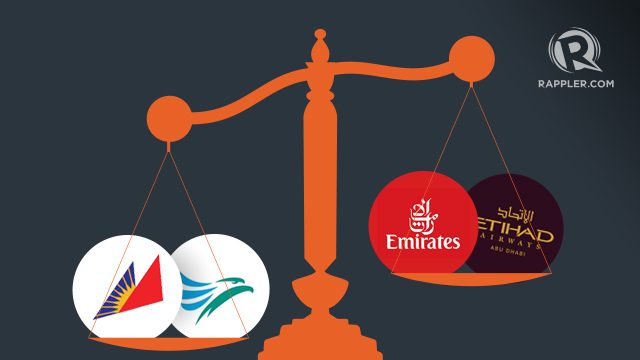SUMMARY
This is AI generated summarization, which may have errors. For context, always refer to the full article.

MANILA, Philippines — The Gulf airlines scored a victory, as the Philippines and the United Arab Emirates (UAE) agreed to expand their air agreement, increasing the maximum flights per week to 35 from 28.
This means competition in the Philippines-Middle East market may intensify, as both Philippine and UAE airlines can now increase their flight operations between the two jurisdictions – an initiative local carriers sought to block.
Earlier this month, major Philippine carriers Philippine Airlines, Incorporated (PAL) and Cebu Pacific Air asked the Civil Aeronautics Board (CAB) to deny the Gulf carriers’ request for additional flights, saying this will only hurt local airlines.
But after air talks from August 27 to August 28 in Manila, the Philippine and UAE air panels decided to sign a new memorandum of understanding (MOU) on air services, enhancing the exchange of traffic rights between the two countries.
CAB Executive Director Carmelo Arcilla said the two countries “agreed to increase the maximum number of flights per week for each country from the current 28 flights to 35.”
“This is still subject to the condition that the UAE carrier operating such additional flights to Manila is bound to also operate separately to Clark or Cebu within one year from signing of the MOU,” Arcilla added.
According to the CAB chief, this condition forces UAE airlines to invest in developmental gateways outside Manila.
Aside from the additional flights, Arcilla said “the Philippines also got on a unilateral basis additional fifth freedom traffic rights to the UK, US and Saudi Arabia.”
This means that local airlines can now fly from Manila to UAE and onward to any country including the UK, the US and Saudia Arabia.
“This will improve Philippine connectivity and also the commercial viability of our routes to the UAE,” Arcilla said.
The Philippine and UAE air panels, according to Arcilla, also agreed on co-terminalization, which means that an airline from one country can fly to a city in the other country without picking up passengers in the domestic leg.
“This also improves connectivity and viability. Overall, the talks is a success for Philippine connectivity and network development. The Philippine government panel and our airlines view the exchange as more or less fair, as the increase in traffic rights for both sides, which our airlines opposed, is minimal,” Arcilla said when sought for comment.
But for PAL and Cebu Pacific, the added capacity was not needed and accused the state-owned Gulf carriers to be operating on an advantage.
High stakes chess game
The UAE is the largest Middle East destination from the Philippines, accounting for slightly over half of the 80,000 weekly return seats between the Middle East and the Philippines, according to independent aviation think tank Center for Asia Pacific Aviation (CAPA).
CAPA added that the UAE is now the fifth largest international destination from the Philippines overall after South Korea, Hong Kong, Singapore, and Japan.
“Clearly there is a lot at play – and at stake,” CAPA said in its 2014 report.
“Manila is Etihad’s second largest international market after Bangkok. As an added incentive, Etihad would be able to potentially increase its share of the Philippine market at the expense of Emirates,” the report read.
CAPA said the “best scenario for Emirates – and Filipino consumers – would be an expansion of the UAE-Philippines bilateral.” — Rappler.com
Add a comment
How does this make you feel?
There are no comments yet. Add your comment to start the conversation.